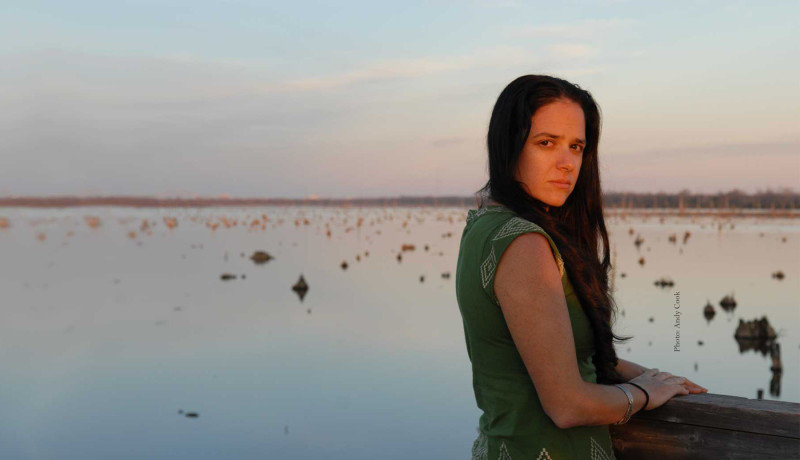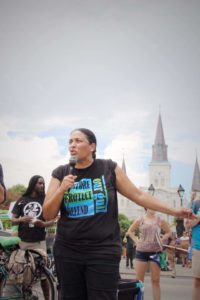5000 miles from Grand Bois. Red Road to Paris.
There is a place in south Louisiana that the people call Grand Bois (Big Woods). My relatives from the Houma Nation have called this place home for hundreds of years. It lies just south of a federal manmade shipping canal (used primarily for the oil and gas industry,) just north of some of the fastest disappearing land on earth, and it happens to be less than 500 feet from a toxic waste facility (US Liquids) where the byproducts of oil & gas production are daily dumped into open air pits the size of football fields where it is “treated.” This little bayou community is almost 5000 miles (7,779 km) away from Paris, where the fate of the world is currently being decided during international negotiations at COP21.

Grand Bois is located within the heart of the Mississippi Atchafalaya River Basin, the 3rd largest river basin in the world, dwarfed only by the Amazon and Congo. My ancestors called this deltaic territory between the Mississippi and the Atchafalaya the Yakni Houma (Houma Land.) Hundreds of tributaries feed into the Mississippi River, draining 41% of the United States and two Canadian provinces. The natural process for the health of a delta is for freshwaters to flood and annually replenish our wetlands with the lifeblood of the earth. But over the last century, man has re-engineered the landscape, channelling the river for flood protection and commerce, cutting off freshwater distributaries which is in turn starving our wetlands and creating annual summer hypoxia off our coast in the Gulf of Mexico; we call it the “dead-zone” because no life is found there. The algal blooms are caused by petrochemical fertilizer runoff coming from midwestern farms.
1/3 of the United States oil and gas is either produced or transported via south Louisiana and the Port of south Louisiana is one of the largest ports in the world. Plantations that once grew indigo and sugarcane are now the sites of multi-national petrochemical corporations. Some of the oldest and largest refineries in the US are located along the Mississippi River. Since colonial times our people have been forced to adapt. What once was a fight for land rights has since become a fight for the right to have clean air and water and land, the most basic human rights, the right to a safe environment where we can raise our children and allow our old people to die with dignity. Instead we have become victims of cancerous greed. We are now enduring the shortsighted side effects of extraction, production and progress.

Since 1932, south Louisiana has lost over 1,900 square miles (3,058 square km). They say every hour, an acre is lost from our shores. We are experiencing more violent and frequent hurricanes and tropical storms and higher surges of water. Hurricane Katrina was not the first and we have had multiple storms since and we know there will be more to come. Just this past October, the largest recorded hurricane on record was born in the Pacific Ocean, it came ashore in Mexico before moving into the Gulf, then pushed northward into south Louisiana as a tropical storm. My cousins who live just south of Grand Bois, down the bayou in Pointe aux Chenes (Point of the Oaks) woke to 2 feet of water in their front yard. Sea levels are rising and the 10,000+ miles of oil and gas canals dredged by the industry for natural resources extraction has left our wetlands in a state of irreparable loss. Freshwaters no longer regularly flood our territory, saltwater instead singes our shores, killing the biodiversity and forcing coastal communities to migrate to higher grounds. They say communities will have be sacrificed and those communities at the ends of the road where the Houma once found refugee is now turning into open waters.
I am here in Paris because of Grand Bois. At 17 years old, I heard my cousin Clarice Friloux tell the story of what was happening in her community, the oil pits and how the state allows hazardous material to labeled nonhazardous. I remember thinking how can we call ourselves civilized when such barbaric behavior is not only allowed, but facilitated by the very people who are supposed to be “representing us.” In hindsight, I have to kind of laugh at my own naivety. What I have learned is that the story of Grand Bois and the struggles of the Houma Nation is not unique. I have heard it echoed in voices from around the world, a story of industry being allowed to move into small, poor communities to take what they want without being held responsible for the degradation they leave behind. From the Arctic to Chile, from Nigeria to North Dakota, from Alberta to Ecuador people are feeling the effects of climate change and carbon colonialism and instead of our governments representing the people industry is often calling the shots.
Norway, the United Kingdom and France are currently trying to omit language within the COP21 negotiations that ensures the rights of indigenous peoples. These are basic human rights. Stay vigilant and light a candle for those negotiators on the inside who are fighting for environmental and social justice and those on the frontlines who are enduring the effects of climate change injustice.
Monique M Verdin, Paris 2015.

———–
 Monique Michelle Verdin is a native daughter of southeast Louisiana. Her intimate documentation of the Mississippi River Deltas’ indigenous Houma nation exposes the complex interconnectedness of environment, economics, culture, climate and change. Her photography has been exhibited nationally and internationally, and is included in The Good Pirates of the Forgotten Bayous, Yale University Press (2008) and Nonesuch Records’ Habitat for Humanity benefit album Our New Orleans (2005). She received her bachelors degree in Mass Communication at Loyola University in New Orleans. My Louisiana Love (2012) is her first documentary film.
Monique Michelle Verdin is a native daughter of southeast Louisiana. Her intimate documentation of the Mississippi River Deltas’ indigenous Houma nation exposes the complex interconnectedness of environment, economics, culture, climate and change. Her photography has been exhibited nationally and internationally, and is included in The Good Pirates of the Forgotten Bayous, Yale University Press (2008) and Nonesuch Records’ Habitat for Humanity benefit album Our New Orleans (2005). She received her bachelors degree in Mass Communication at Loyola University in New Orleans. My Louisiana Love (2012) is her first documentary film.




